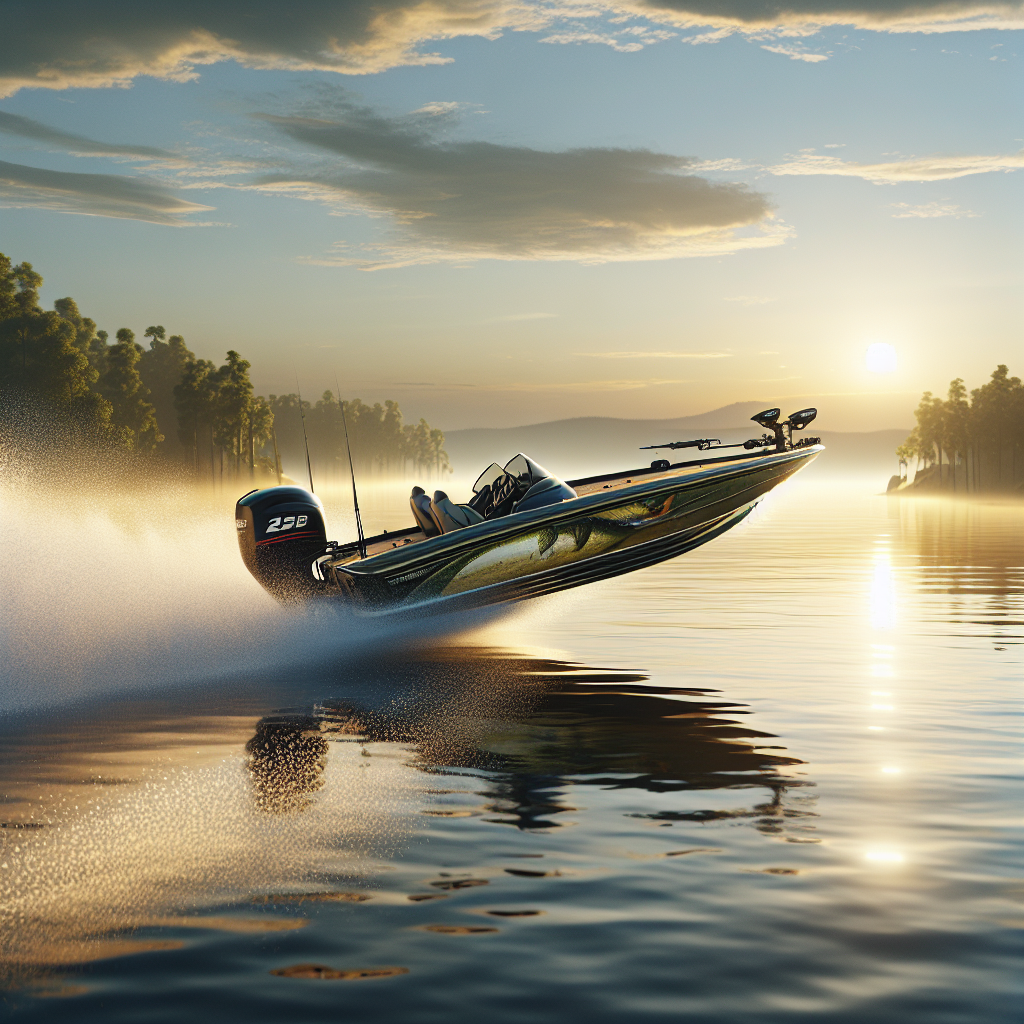Understanding the Basics of Planing a Bass Boat
What is Planing?
Planing refers to the process of gliding over the water’s surface instead of plowing through it. This method significantly increases speed and efficiency, reducing drag and resistance in the water. Planing requires the boat to have a specific angle to its hull to create lift forces, propelling the boat forward over the water’s surface.
Importance of Achieving the Correct Plane
The main advantage of achieving the correct plane is speed and fuel efficiency. A bass boat that is not correctly planing may consume excess fuel and can lead to sluggish performance. A boat that is set up correctly for planing will also improve handling and ride comfort. Failure to achieve the proper plane can result in a boat that is difficult to steer, feels unstable, and may not allow optimal speed.
Factors Affecting Planing in Bass Boats
| Factor | Description |
| Weight and balance of the boat | The ideal balance should be between the boat’s bow and stern. A misplaced load or too much weight in one area of the boat can prevent it from achieving the correct plane. |
| Boat design | The hull shape and design can affect the boat’s ability to plane. Boats with flat or shallow V-shaped hulls are easier to plane than boats with deep-V hulls. |
| Motor horsepower and propeller | The boat’s motor horsepower directly affects its ability to plane. Propeller pitch affects the boat’s ability to maintain the correct plane once achieved. |
| Water conditions | The water’s depth, chop, and current can all affect a boat’s ability to plane. |
Preparing Your Bass Boat for Planing
Before attempting to plane your bass boat, make sure it is in good condition and properly prepared for the task. Here are some important steps to take:
Checking the Boat’s Condition
Inspect your boat for any cracks, leaks, or damage. Check the screws and bolts for tightness and make sure all electrical components are functioning properly. Any issues should be addressed before attempting to plane the boat.
Proper Weight Distribution
Weight distribution is crucial for proper planing. Make sure your boat is loaded evenly and avoid having too much weight in the front or back. If necessary, shift weight to achieve a balanced load.
Adjusting the Trim and Tilt
Trim and tilt adjustments help optimize the boat’s performance while planing. Trim adjusts the angle of the propeller, while tilt controls the motor’s angle. To achieve optimal planing, adjust the trim and tilt as needed, based on your boat’s size, weight, and conditions.
Ensuring Safety Before Takeoff
Before taking off, ensure that all passengers are wearing life jackets. Check that your boat’s navigation lights and horn are working. It’s also important to have a clear understanding of the water conditions and weather forecast.
Mastering Throttle Control
Throttle control is a critical component of planing your bass boat and achieving optimal speed. Understanding throttle response and the role of acceleration is key to mastering your boat’s planing capabilities. Here are some tips for mastering throttle control:
- Start gradually: Begin by gradually increasing the throttle until you reach planing speed. Avoid ramping up the throttle aggressively as it can cause the boat to bounce and lose stability.
- Listen to your boat: When driving your boat, listen for the engine sound. As you approach planing speed, the engine pitch will change, indicating that the boat is about to plane.
- Consider engine tilt: Adjusting the engine tilt can help achieve optimal planing speed. Typically, tilting the engine slightly up will enhance speed, while tilting it down will improve stability.
- Finding the sweet spot: Once you’re at planing speed, it’s essential to find the sweet spot, which is the point where the boat glides smoothly on the water surface. It’s the optimal speed that you want to maintain while planing.
Mastering throttle control may take some practice, but by performing gradual adjustments and listening to your boat, you can achieve the perfect planing speed.
Fine-Tuning Trim and Tilt for Perfect Planing
Using Trim to Optimize the Plane
Trim is a tool that can be used to optimize the plane of your bass boat. Adjusting the boat’s trim angle modifies the angle of the hull in relation to the water’s surface. If the hull is angled too low, it can create drag, which can slow down the boat. If it’s angled too high, the boat may struggle to plane.
When you begin to approach your boat’s ideal planing speed, raise the trim angle slightly using the tilt/trim switch. This causes the bow to lift higher, reducing drag and increasing your speed. However, if the bow lifts too high, you may lose control of your boat, so it’s vital to avoid over-trimming.
Maintaining Balance with Tilt
The trim angle and boat tilt are closely related, and both need to be taken into account when trying to plane smoothly. Tilting the motor upright moves its center of gravity further forward, which shifts the weight distribution of the boat forward and lifts the bow.
To achieve the ideal planing position, make small adjustments to the tilt and trim angles of the boat as you move towards the optimal speed. Make sure the tilt is aligned with the trim angle to maintain balance, as overcompensating with tilt can stabilize the boat but can also cause a loss of speed.
The Effects of External Conditions on Trim and Tilt
External conditions, particularly wind and wave height, will impact the trim and tilt angles required for optimal planing. In high wind or high sea situations, it can be necessary to bring the tilt angle forward and lower the trim to maintain control of the boat. Conversely, in flat water conditions, raising the trim angle can cause the boat to plane more efficiently and achieve higher speeds.
Use these external factors to your advantage, adjusting your boat’s angle accordingly to achieve the ideal plane for your current conditions.
| Data Point | Description |
|---|---|
| Trim | A tool that can be used to optimize the plane of your boat by adjusting the boat’s trim angle modifying the angle of the hull in relation to the water’s surface |
| Tilt | Another tool that can be used to maintain balance with trim, by tilting the motor upright and moving its center of gravity forward-shifting the weight distribution of the boat forward and lifting the bow |
| Effect of wind and wave height on plane | External conditions, particularly wind and wave height, will impact the trim and tilt angles required for optimal planing. In high wind or high sea situations, it can be necessary to bring the tilt angle forward and lower the trim to maintain control of the boat. Conversely, in flat water conditions, raising the trim angle can cause the boat to plane more efficiently and achieve higher speeds |
Advanced Techniques and Troubleshooting
Handling Challenging Weather and Water Conditions
One of the biggest challenges for any bass boat enthusiast is dealing with challenging weather and water conditions. From high winds and rough waters to changing temperatures and currents, there are many factors that can impact your boat’s performance and make it more difficult to achieve optimal planing. To combat these issues, it’s important to pay attention to the weather and water conditions before heading out on your next boating trip. This can involve checking weather reports and water conditions in advance, as well as making sure you have the right gear and equipment to handle any challenges that may arise.
Dealing with Planing Issues
Dealing with planing issues is another challenge that many bass boat enthusiasts will face at some point. This can include issues with acceleration, throttle response, and maintaining balance and stability on the water. In order to address these issues, it’s important to start by diagnosing the underlying problem. This can involve conducting a thorough inspection of your boat’s engine, propeller, and other key components, as well as making sure your weight distribution and trim settings are optimized for peak performance. With the right knowledge and expertise, you can tackle even the toughest planing issues and get back to enjoying your time on the water.
Tips and Tricks from Bass Boat Experts
Finally, it’s always helpful to learn from the experts when it comes to mastering the art of bass boat planing. Whether you’re looking for tips on throttle control, trim settings, weight distribution, or any other aspect of boat performance, there are plenty of resources available that can help. Some great places to start include online forums, boating magazines, and expert blogs and websites. By taking advantage of these resources, you can stay up-to-date on the latest trends and techniques in the world of bass boat planing and keep your skills sharp for years to come.
Maintaining Your Bass Boat for Consistent Performance
Last but not least, it’s important to remember that proper maintenance is key to achieving consistent performance and optimal planing with your bass boat. This can involve regular inspections and tune-ups of your engine, propeller, and other key components, as well as proper cleaning and storage of your boat after each use. By taking the time to care for your boat and keep it in top shape, you can maximize your investment and enjoy many years of memorable boating experiences.
Frequently Asked Questions
- Q: What is the sweet spot for optimal speed in bass boat planing?
- Q: What are some common planing issues that bass boat enthusiasts face?
- Q: How often should I conduct maintenance on my bass boat?
A: The sweet spot for optimal speed will depend on a variety of factors, including the size and weight of your boat, the condition of your engine and propeller, and the water and weather conditions. As a general rule, however, most experts recommend aiming for a speed of around 25-30 mph when planing with your bass boat.
A: Some common planing issues that bass boat enthusiasts may face include issues with acceleration, throttle response, and maintaining balance and stability on the water. These issues can be caused by a variety of factors, including improper weight distribution, suboptimal trim settings, or issues with the boat’s engine or propeller.
A: It’s generally recommended that you conduct regular maintenance on your bass boat at least once per year, or more frequently if you use your boat frequently or in challenging conditions. This can involve regular inspections of your engine, propeller, and other key components, as well as proper cleaning and storage of your boat after each use.


